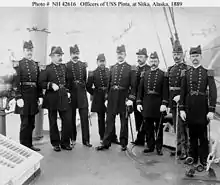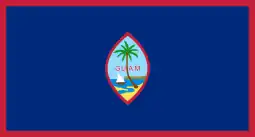Robert Coontz
Robert Edward Coontz (June 11, 1864 – January 26, 1935) was an admiral in the United States Navy, who sailed with the Great White Fleet and served as the second Chief of Naval Operations.
Robert Edward Coontz | |
|---|---|
 Admiral Robert E. Coontz, USN | |
| Born | June 11, 1864 Hannibal, Missouri |
| Died | January 26, 1935 (aged 70) Puget Sound Naval Hospital, Bremerton, Washington |
| Buried | Mount Olivet Cemetery, Hannibal, Missouri |
| Allegiance | United States |
| Service/ | United States Navy |
| Years of service | 1881–1928 |
| Rank | Admiral |
| Commands held | Fifth Naval District United States Fleet Chief of Naval Operations Puget Sound Navy Yard USS Georgia Governor of Guam |
| Battles/wars | Spanish–American War Philippine–American War Battle of Veracruz World War I |
| Awards | Navy Distinguished Service Medal Commander of the Legion of Honour (France) |
Early life
Robert Coontz, son of Benton Coontz, was born in Hannibal, Missouri. His parents were originally from Florida, Missouri, where they had been neighbors and schoolmates of a young Sam Clemens. Robert's father was involved in several businesses, including owning Hannibal's streetcar system. While a young boy, Robert Coontz left his name for posterity by carving it into the rock of Mark Twain Cave, then known as McDowell's Cave.[1] After completing his primary education in Hannibal public schools, Coontz attended Inglesile College from 1878 to 1879, and Hannibal College (now Hannibal-LaGrange University) from 1879 to 1880.[2] Coontz asked family friend Congressman William H. Hatch for an appointment to the United States Naval Academy. However, several other young men from the congressional district also desired the appointment so a competitive exam was arranged, which Coontz won.
Naval career

Coontz graduated from the Naval Academy in 1885, and served at the Navy Department and in several ships over the next decade, among them vessels stationed in Alaskan waters and the Great Lakes. He returned to the Navy Department late in 1894, to work on updating officer records, then was assigned to the cruiser USS Philadelphia, the Coast Survey and the cruiser USS Charleston. During the Spanish–American War Charleston and Coontz seized control of Guam, then joined Admiral George Dewey's forces in the Philippines. Coontz would remain in the Pacific, seeing action in the Philippine–American War.[3] Following further duty afloat and ashore, Coontz, then a lieutenant commander, was Executive Officer of the battleship USS Nebraska during the 1907–1909 world cruise of the "Great White Fleet".
In 1899, Coontz became a Veteran Companion of the Pennsylvania Society of the Military Order of Foreign Wars.
After promotion to commander in 1909, Coontz was Commandant of Midshipmen at the Naval Academy. In 1912–13, he was Governor of Guam. Captain Coontz then served as Commanding Officer of the battleship USS Georgia, followed by duty as Commandant of the Puget Sound Navy Yard and the 13th Naval District. He held those positions until late in 1918. Following a brief period as acting Chief of Naval Operations, Rear Admiral Coontz assumed command of a battleship division in the Atlantic.
Coontz had just been assigned to the Pacific Fleet in September 1919, when he was selected to become Chief of Naval Operations (CNO), succeeding Admiral William S. Benson. Reportedly, his term as CNO was marked by unceasing pressure for economy, Congressional unhappiness over base closings, diplomatic efforts to achieve naval limitations, internal Navy Department conflicts over organization and the best ways to manage new technologies, plus the naval fallout of the Teapot Dome scandal. While dealing with these problems, Admiral Coontz established a unified United States Fleet and strengthened the CNO's position within the Navy Department.
Relieved as CNO in August 1923, by Admiral Edward W. Eberle, Coontz was able to return to sea as Commander in Chief of the United States Fleet. In 1925, he led the fleet on a trans-Pacific visit to New Zealand and Australia, the first massed deployment of American battleships since the "Great White Fleet" cruise, nearly two decades earlier, and a valuable demonstration of their strategic reach. Admiral Coontz is also acknowledged for his key role in the promotion of US naval aviation. He lobbied for converting the USS Lexington and USS Saratoga from Lexington-class battlecruisers to Lexington-class aircraft carriers following the Washington Naval Treaty, ships that would prove vital for training in the inter-war years and as fighting ships during World War II.[4] From October 1925, until his retirement in June 1928, Coontz served as Commandant of the Fifth Naval District, reverting to the rank of rear admiral.
Retirement and death
After retiring, Coontz wrote a memoir chronicling his early life growing up in Hannibal, Missouri, and his navy career, titled From the Mississippi to the Sea.[2] A second book, True Anecdotes of an Admiral, was published in 1934.[5] Coontz was briefly recalled to active duty in 1930, to investigate railroads in Alaska. Two years later in 1932, Coontz would represent Alaska at the Democratic National Convention. It was also in 1932, that he became Commander-in-Chief of the Veterans of Foreign Wars.[6] After suffering a series of heart attacks beginning in 1934, Admiral Robert E. Coontz died on 26 January 1935, at the Puget Sound Naval Hospital in Bremerton, Washington. Coontz is buried in Mount Olivet Cemetery in his native Hannibal, Missouri.
Namesake
- Coontz (DLG-9), a Farragut-class destroyer leader/frigate and Admiral R. E. Coontz (AP-122), a Admiral W. S. Benson-class transport were named in his honor.
- The Admiral Coontz Armory in Hannibal, Missouri is named in his honor.[7]
- Coontz Junior High School in Bremerton, Washington. Destroyed by fire December 15, 1974.
References
- Murray, Ed (28 July 2011). "Admiral Robert E. Coontz". Hannibal Magazine. Archived from the original on 21 January 2013. Retrieved 3 July 2012.
- Dictionary of Missouri Biography, Lawrence O. Christensen, University of Missouri Press, 1999, Pg. 207–208
- Dictionary of Missouri Biography, Lawrence O. Christensen, University of Missouri Press, 1999, Pg. 207–208
- "Biography in Naval History – Admiral R.E. Coontz". U.S. Navy Historical Center. August 11, 2008. Retrieved 3 July 2012.
- Dictionary of Missouri: Biography, Lawrence O. Christensen, University of Missouri Press, 1999, Pg. 207–208
- "Admiral R.E. Coontz bio". Department of the Navy, Naval Historical Center. Retrieved 3 July 2012.
- "Admiral Coontz Recreation Center". Hannibal Parks & Recreation Department. Retrieved 3 July 2012.
- This article incorporates text from the public domain Dictionary of American Naval Fighting Ships.
- Robert E. Coontz (1930) From the Mississippi to the Sea. Philadelphia: Dorrance & Co, Inc. See also "United States Naval History: A Bibliography". Retrieved 2008-01-01.
External links
- From the Mississippi to the Sea (autobiographical memoir by Adm. Coontz, 483pp, 1930)
- Naval Historical Center
- "Robert Coontz". Find a Grave. Retrieved 2008-02-11.
| Military offices | ||
|---|---|---|
| Preceded by William S. Benson |
Chief of Naval Operations 1919–1923 |
Succeeded by Edward W. Eberle |
| Preceded by Hilary P. Jones |
Commander in Chief, United States Fleet 1923–1925 |
Succeeded by Samuel S. Robison |
